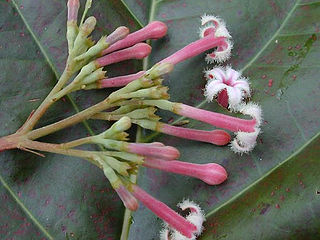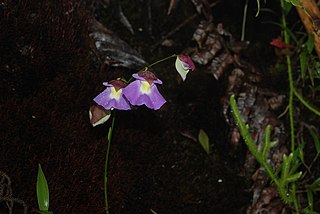
Peperomia is one of the two large genera of the family Piperaceae. It is estimated that there are at least over 1,000 species, occurring in all tropical and subtropical regions of the world. They are concentrated in South and Central America, but may also be found in southern North America, the Caribbean islands, Africa, Oceania, and southern and eastern parts of Asia. The exact number of species is difficult to determine, as some plants have been recorded several times with different names, and new species continue to be discovered. Peperomias have adapted to many different environments and their appearances vary greatly. Some are epiphytes or lithophytes, and many are xerophytes or possess underground tubers (geophytes). Most species are compact perennial shrubs or vines.

Azorella is a genus of flowering plants in the family Apiaceae, native to South America, New Zealand, southeastern Australia, and the islands of the Southern Ocean.

Calceolaria, also called lady's purse, slipper flower and pocketbook flower, or slipperwort, is a genus of plants in the family Calceolariaceae, sometimes classified in Scrophulariaceae by some authors. This genus consists of about 388 species of shrubs, lianas and herbs, and the geographical range extends from Patagonia to central Mexico, with its distribution centre in Andean region. Calceolaria species have usually yellow or orange flowers, which can have red or purple spots. The Calceolaria Herbeohybrida group, also called C. herbeohybrida Voss, is a group of ornamental hybrids known only in cultivation, called florists' slipperwort.

Soliva sessilis is a species of flowering plant in the family Asteraceae. It is one of up to nine species of the genus Soliva and is a low-growing herbaceous annual plant. Its common names include field burrweed, Onehunga-weed, lawn burrweed, lawnweed, jo-jo weed and common soliva. It is one of several plants also known as bindi weed, bindii, or bindi-eye.

Azara is a genus of eleven species of flowering plants in the family Salicaceae. They are native to temperate to subtropical regions of South America, from southern Brazil and Bolivia to southern Argentina and Chile. They are most often found at woodland margins and lakesides. Azara was formerly classed in the family Flacourtiaceae.

Alonsoa is a genus of 12 species of flowering plants in the family Scrophulariaceae. The genus includes both herbaceous and shrubby species.

Salpiglossis is a genus of flowering plants belonging to the subfamily Cestroideae of family Solanaceae. It is closely related to the genus Reyesia, with which it makes up the tribe Salpiglossideae. Species in the genus Salpiglossis are found in Mexico, Argentina and Chile.

Iriartea is a genus in the palm family Arecaceae. It is native to Central and South America. The best-known species – and probably the only one – is Iriartea deltoidea, which is found from Nicaragua, south into Bolivia and a great portion of Western Amazonian basin. It is the most common tree in many forests in which it occurs.

Cinchona pubescens, also known as red cinchona and quina or kina, is native to Central and South America. It is known as a medicinal plant for its bark's high quinine content- and has similar uses to C. officinalis in the production of quinine, most famously used for treatment of malaria.

Utricularia unifolia is a species of perennial, medium-sized carnivorous plant that belongs to the family Lentibulariaceae. U. unifolia is native to Central America and western South America. It was originally published and described by Hipólito Ruiz López and José Antonio Pavón Jiménez in 1797 and later considered a synonym of Utricularia alpina until Peter Taylor's 1989 monograph on the genus where he restored the species as distinct from U. alpina. It grows as a terrestrial or epiphytic plant on moss-covered trees, rocks, or banks in cloud forests at altitudes between 2,000 m (6,562 ft) and 3,000 m (9,843 ft). U. unifolia usually produces only one leaf, which is where the species epithet "unifolia" is derived from.

Bowlesia incana is a species of flowering plant, known by the common name hoary bowlesia, in thefamily Apiaceae. It is native to South America and the southeastern and southwestern United States as far north as Washington. It can also be found in Pakistan and New Zealand as an introduced species. It grows in many types of habitat. This is a small annual herb growing thin, spreading stems less than 60 centimeters long. The leaves are borne on long petioles and have multilobed rounded or kidney-shaped blades less than 3 centimeters wide. The green herbage of the plant is coated in fine white hairs. The inflorescences of yellow-green flowers appear in the leaf axils. The tiny inflated fruit is only 2 millimeters wide.

Salvia oppositiflora is a species of perennial flowering plant in the famiily Lamiaceae. It is native to Peru, growing at high elevations—7,000 to 12,000 feet. It was collected in 1798 by Hipólito Ruiz López and José Antonio Pavón Jiménez and later described in Flora of Peru.

John Lindley published Epidendrum subg. Spathium of the Orchidaceae. According to Lindley's diagnosis, the E. subg. Spathium is recognizable by is sympodial habit with individual stems being slender and covered by the bases of the distichous leaves, by the lip of the flower being adnate to the column to its apex, and by the inflorescence emerging from at least one spathe, similar to nearly all members of the genus Cattleya as understood in the year 2000. Reichenbach recognized 52 species in this subgenus, of which Kew accepts 48 :

Campomanesia lineatifolia is a species of plant in the family Myrtaceae. Common names include guabiraba and perfume guava.
Peperomia umbilicata is a species of flowering plant in the family Piperaceae. It is endemic to Peru. It is a geophytic plant, storing water and reserves in an underground tuber. During dry periods parts above ground, such as leaves, will wither away but the plant will survive due to the tuber. When more rain falls the plant regrows its stalks and leaves on the surface.
Peperomia acuminata, is a species of flowering plant in the family Piperaceae. Its native range reaches from central South America to Central America and the West Indies.

Peperomia tetragona is a species of flowering plant in the family Piperaceae. It is native to South America with a range from Ecuador, Peru, and Paraguay to central/western Brazil. Long grown as a houseplant in temperate climates, it is often known by its synonym Peperomia puteolata or as the parallel Peperomia for the parallel venation on its elliptical leaves.
Peperomia vellarimalica is a species of plant from the genus 'Peperomia'. It grows in wet tropical biomes. It was discovered by Jose Mathew and Pichan Salim in 2018. They named it after a nearby Mountain Range in Kerala, India.















